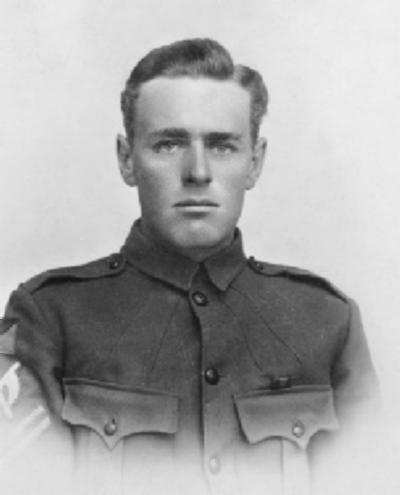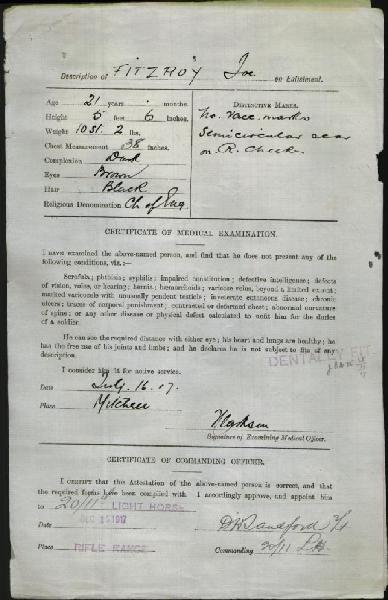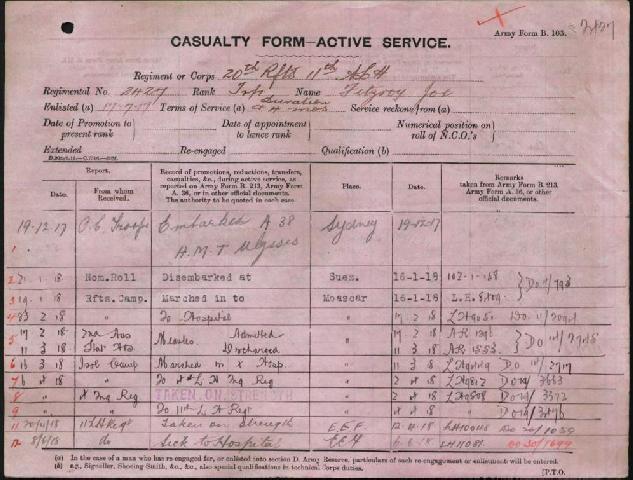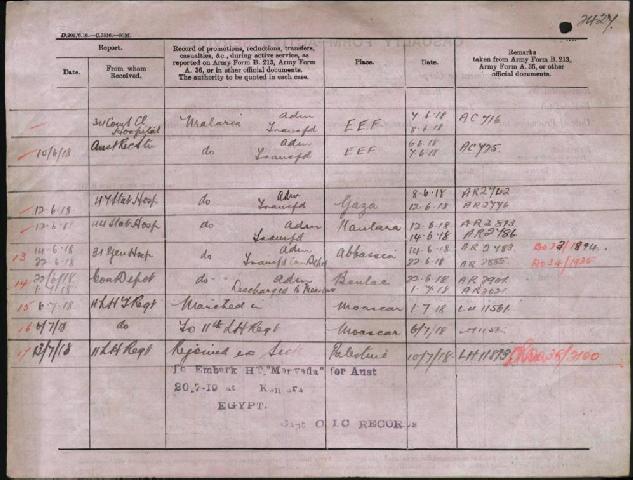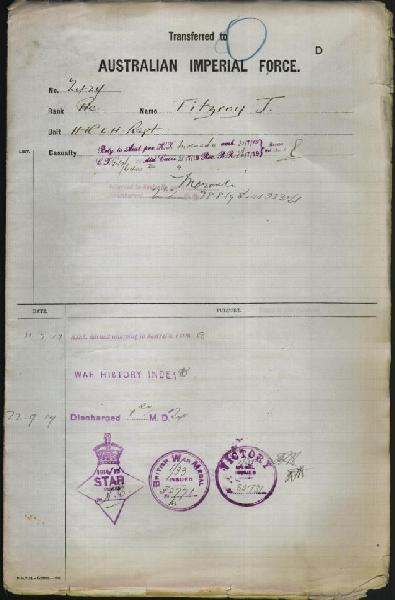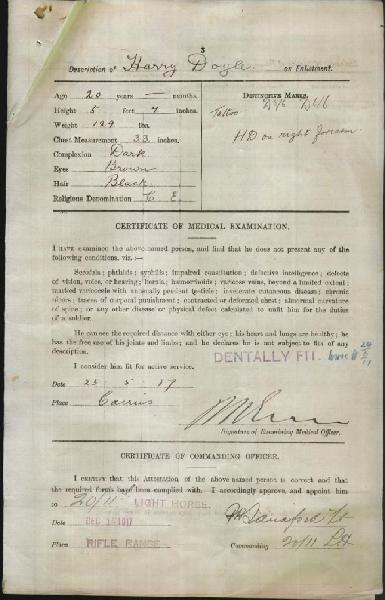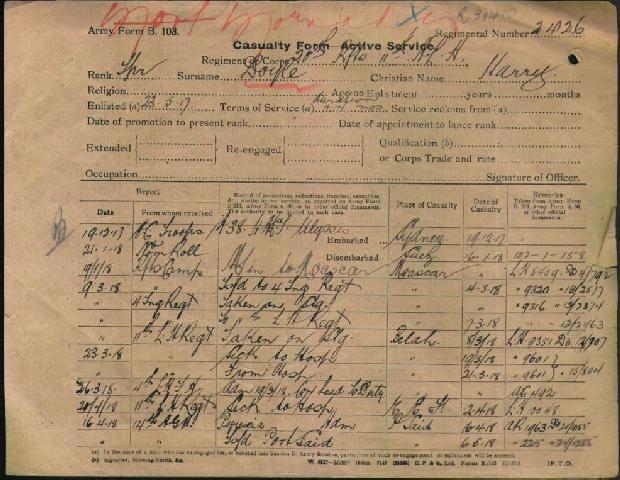Topic: AIF - 4B - 11 LHR
11th Light Horse Regiment, AIF account about its participartion within the Jordan Valley
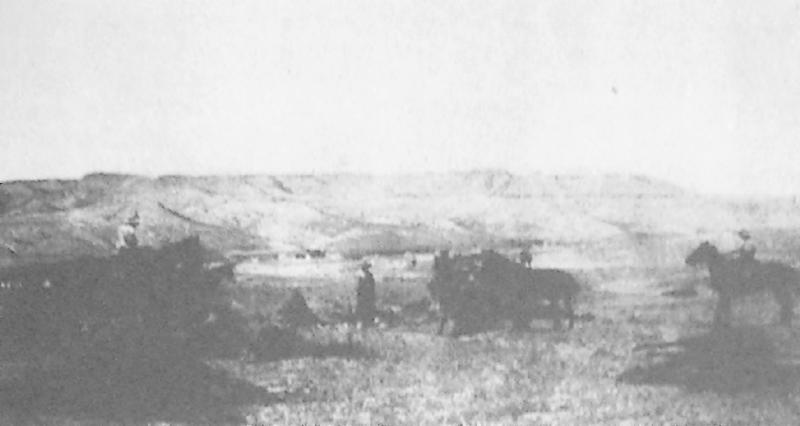
The 11th LHR horse lines just before the bombing raid of 7 May 1918
[From: Hammond, History of the 11th Light Horse Regiment, p. 112.]
Hammond, EW, History of the 11th Light Horse Regiment, Fourth Light Horse Brigade, Australian Imperial Forces, war 1914-1919, (Singapore 1984), pp. 120 - 5:
CHAPTER XVII.
JORDAN VALLEY (Continued).
The Valley of the Jordan forms one of the most remarkable depressions on the face of the earth, being wholly below the level of the sea. The lake of Tiberias, at its northern end, is 300 feet below sea level, and the Dead Sea, at its southern extremity, is 1,300 feet below sea level. The distance between these two points in a direct line is 70 miles, but the River Jordan follows a course 200 miles long in its crooked windings before it enters the Dead Sea. The floor of the valley varies in width from 4 to 15 miles, and on the east and the west the mountain ranges of Moab and Judea, respectively, rise to a height of 4,000 feet, the former terminating in the purple-tinted peak of Mount Nebo, where, according to tradition; Moses stood when shown the "Promised Land." The Jordan River discharges more than six million gallons of water per day into the Dead Sea, which has no physical outlet, the level being maintained by evaporation alone. The saline content of the Dead Sea is approximately 24 per cent., and fish swept into it by waters of the Jordan are unable to exist and very soon their bodies become mummified by the chemical action of the waters.
The course of the river is marked by a thin line of willow trees, and in places throughout the valley the lesser waterways support straggling patches of willow and tamarisk, but for the most part the plains on either side of the river are parched. barren and uninviting. The summer temperature rises as high as 127 degrees (F.), and rarely falls below 100 degrees (F.).
The Arabs who make their homes in the valley evacuate to the higher regions of Judea in the summer months, believing the place to be uninhabitable at that time, and so, like the Courts of Jamshyd, the valley is left to the ravages of beast and reptile. Packs of starving jackals trot back and forth snarling and fighting amongst themselves for want of a more lucrative occupation, and the nights are made hideous by the terrifying laughter of the fierce hyena. The stony hillsides, the dry wadis, and the swamps along the waterways are infested with snakes, scorpions and a loathesome variety of hair- black spider the size of a man's hand. The Diggers instinct for gambling throve amidst these hazards, and many a piastre was won and lost on the fierce conflicts staged by the soldiers between scorpions and spiders that fought to the death in a tin hat or a regimental washing dish. These "trial bouts" were noisy affairs, being staged to the accompaniment of excited barracking by groups of soldiers, who, having placed their bets where fancy dictated, clustered around the "arena" to urge their champion to greater effort.
We were told that the super-venomous reptile known as the "asp" infested that wilderness, and that the scientific squad at military headquarters in Jerusalem required specimens for research purposes. "Any man who brought one in alive," the order concluded, "would be suitably rewarded," and next day every Digger who was not actually in the firing line could be seen tramping to and fro across the hillsides with a forked stick in his hands.
I have often wondered what the Arabs thought of the landscape, when they returned after the summer of 1918, to find all those overturned stones as though nature, in a whimsical mood, had conducted a giant flip-flap throughout the valley. Literally, no stone was left unturned in the treasure hunt for asps, and besides many other varieties of snakes and even lizards were brought in for classification and award. It was not long before a frantic note came down from the "Scientific Squad" cancelling the order for "live snakes," and some of our boys who visited the laboratory at Jerusalem about that time with their own particular discoveries were asked by an Australian assistant whether they thought he was "runnin' a flamin' sideshow."
Our sergeant-major threatened to "crime" the next "bloke" who brought in a live snake, but we think his ultimatum was prejudiced by the action of a signaller from Crow's Nest, Queensland, who, having captured an 8 foot black snake on the bank of the Auja River, left it tied to a stick in the sergeant-major's bivvy while he went in search of the adjutant to claim his reward.
"How was I to know," he said, in explanation afterwards, "that the S.M. would get back to his tent before I did?"
The dust and heat in the valley were terrific, and with inadequate rations and myriads of flies and mosquitoes to harass us, the health of the troops became seriously jeopardised. The slightest scratch was converted by conditions into an angry, vicious sore overnight, and almost every trooper was a daily visitor to the A.M.C. tent with major or minor ailments. Boils were prevalent and by reason of their anatomical situation reduced a fair percentage of the horsemen to the ground-level of the "foot-sloggers."
Occasionally we swam in the sluggish brown waters of the Jordan or rode down to the "sea" for a brief respite from the heat and dust. Old Arabs who haunt the shores of the Dead Sea will tell you with a great show of superstition and awe, that no bird will fly across its waters lest it be struck dead by some malign and sinister influence that pollutes the air above and around it, a deadly legacy, they presume, arising from the ashes of Sodom and Gomorrah. The explanation, however, is both simple and complete. There is no fish life in the waters of the Dead Sea, and consequently no bird life above it; but when we proffered this theory to an ancient Arab he merely shook his old head and made gestures of pity in favour of our ignorance.
The Mount of Temptation, with its frowning convulsions, rose at the back of and almost overshadowed our camp, and near the top, cut into the cliff face, we could see a Greek monastery.
In places the building overran the cliff wall, depending for support on stout beams and props, and from the valley below it resembled nothing so much as a pigeon house.
Jericho is a small straggling village of mud huts, set in a shimmering world of unreality, and there is no trace of the famous balsam gardens of Cleopatra's day. There were signs of old Roman roads winding out of the valley, but where in Palestine are such roads not to be found?
On 11th May the Regiment relieved the I.C.C. in a section of the defence line Musallabeh-Abu Tellal, and we immediately entrenched and began consolidating the position. The Turks shelled the position freely, but made no decisive attack upon it. Every afternoon we were shelled by a long range gun known to the troops as "Jericho Jane." The gun was well placed in the hills at Shunet Nimrin, about ten miles east of the river. A batch of reinforcements which joined the Regiment here comprised about 30 Australian aboriginals who, as it was proved later, made good soldiers and did not hesitate to mix it with Abdul whenever an opportunity offered. Being gifted with good sight and hearing, legacies of their Australian environment, they were extremely efficient on outpost duty, although there was probably some justification for the troop-sergeant who said "the cows can hear too well for my liking." It appears he had taken four of the black boys out on a "listening post" one night and they heard so many suspicious sounds, inaudible to anyone else, that the sergeant was compelled to "stand to" all night.
We conducted vigorous patrols in this area until relieved on 8th June, when we marched, via Jerusalem, to a camp at Solomon's Pools, near the town of Bethlehem, arriving there on 13th .June. On the 15th, Lieut.-Colonel J. W. Parsons, D.S.O., reported from Australia and resumed command of the Regiment.
BETHLEHEM.
The camp site was well chosen amidst green swards and smiling fields, presenting a restful and intriguing contrast to the dusty, wrinkled face of the Jordan Valley. The ancient brown road to Hebron wound up a pleasant hill close to our horse lines, and late in the evening Arabs, in picturesque garb, passed by with their herds of black goats, bound for the market places of Bethlehem and Jerusalem, just as their ancestors did in the days of Abraham. A field of green barley, leaning to the road, recalled the immortal romance of Boaz and Ruth.
Organised parties visited the holy places in Jerusalem and Bethlehem, and the ancient walls of David's city echoed and re-echoed to the tread of riding boots and the age-old flagstones flung back the musical tinkle of spurs as Light Horsemen followed their guides from one holy place to another. They walked the road to Calvary and stood in the Church of the Holy Sepulchre, listening in silent reverence to the simple story of "the Man who came out of Nazareth": with equal reverence they would pile their spurs and leggings and boots at the entrance to the Dome of the Rock, and follow the Moslem guardian noiselessly on stockinged feet into that grand monument of Islam Piety, the Mosque of Omar, there to gather round a slab of black rock that once formed part of the threshing floor of Araunah the Jebusite. Is it any wonder that it was found so easy, amidst these surroundings, to conjure visions of Solomon the Great, and of Hiram, King of Tyre.
Of all the places in Jerusalem, from a spiritual point of view, there is none quite like the Garden of Gethsemane. To walk in the cool, soft shadows cast down by the old old olive trees, and to hear the wind whispering in the stately cypress along the terraces is an experience never to be forgotten. Over everything in the garden there is a calm and restful sensation of infinite peace, and the little borders of rosemary, emblem of fidelity, seem to coerce one to the knowledge, that here at least. In this hillside garden there is sublime and absolute evidence of the earthly presence of Him who walked that way.
In Gethsemane the poet's words are clothed with a new and more beautiful significance:
One is nearer God's Home in a garden,
Than anywhere else on earth.
The Australian Light horseman wait a true "soldier of fortune," riding the highways and byways of three of the oldest countries In the world, disposing of their Ancient riddles with a Jest and a laugh, but in Jerusalem he clothed himself in a mantle of serious reverence for the holy places, and it was officially stated that there were fewer cases of military misconduct in Jerusalem than in any other city visited by the Light Horse. Moreover, the magnitude of the voluntary Church parades from our camp to the Church of the Nativity at Bethlehem and the Holy Sepulchre in Jerusalem must have gladdened the heart of our padre who had at last come into his own.
We spent three weeks in the camp at Bethlehem and on the morning of 28th June were ordered to return to the Jordan Valley, where we occupied the defence line at Wadi Nueiamah, north of Jericho. Towards the end of June the enemy had been persistently shelling our defences west of the Jordan, and early in July the activity in the enemy lines seemed to presage a general attack, which did not develop, however, until the morning of 14th July.
Owing to the broken nature of the ground our front line was made up of a number of strong detached posts, supported by smaller outposts adjacent to them. One Light Horse commander was asked by headquarters whether he thought the front line would withstand a determined attack, and the official historian relates that he replied: "No, they are bound to come through." "What of the posts?" he was asked, "The posts," he answered, "will stand unless they are withdrawn for tactical reasons or completely destroyed. Since we landed on the Peninsula (Gallipoli) I have not known a single instance of Light Horse troops, whether under officers or non-commissioned officers, having given up a position they were ordered to hold," and despite the terrifying and sickening conditions In the Valley, that was the spirit that endured throughout the Light Horse lines, Later in the day, as wave upon wave of German and Turkish Infantry were thrown against the line, some of the posts were captured by the enemy, but not until every Australian in them was either killed or wounded. As the enemy streamed down the wadis between the Australian posts he was assaulted by a withering fire from all angles, and by 9 a.m. on tilt, 15th the attacking force was completely demoralised. One hundred and five enemy dead, and 45 wounded were found inside our lines. The prisoners numbered 426 of whom 358 were Germans. This attack was the last offensive attempted against the British forces in Palestine, and by his success in this engagement the Light Horseman demonstrated his superiority, not only over tile Turk, but over German storm trooper its well.
During the engagement the Regiment was bombed by seven enemy aeroplanes, three man being killed and four wounded. Those who made the supreme sacrifice were:-
Trooper A. M. Downie.
Driver W. Emmert
Trooper A. J. Smith.
[See note below - ed..]
Animal casualties were six horses killed and eight wounded.
History relates that Mark Antony transported snow from the heights of Mount Hermon to freeze the drinks he served to Cleopatra in Jericho, but it was left to an enterprising supply officer to bring BEER to the thirsty Diggers in the Jordan Valley in the summer of 1918. The official Field Diary records the event thus:
Place: Jericho, Jordan Valley. Date: 3rd August, 1918.
Hour: 1800 (6 p.m.).
Summary of Event: 12 cases of beer received for 11th Regiment.
Remarks: Nil.
Apparently this super-extraordinary event left our diarist speechless.
At 7 a.m. the following day the Regiment moved to Saba Ridge in support of the 1st Brigade, and lay in the sweltering heat, temperature 120 degrees, throughout the day. Owing to the heavy shelling we were unable to water the horses at the Auja until after nightfall.
The following day we occupied the defence line on the Auja and remained there until 10th August, when the Regiment was relieved by the Allwar (Indian) Infantry and we were ordered to proceed to Ludd for the purpose of reorganisation. On 13th August the Regiment left the Jordan Valley for the last time, and traversing the old Roman road to Talat ed Dumm, turned north-west, passing through the towns of Enab and Latron, arriving at Ludd on 15th August.
Note regarding casualties of the Battle at Abu Tellul, 14 July 1918.
The known casualties from all units are listed below.
BELL Clive Roy 836 Pte 12 LHR/4 LH MGS WIA 14-7-18
BIRCH Charles Napier 66 Cpl 4 LHR WIA 14-7-18
BODEY William Albert 3779 Pte 4 LHR WIA 14-7-18
BROUGHTON David Blakeney Rhys Lt 5 LHR WIA 14-7-18 at Wadi Mellahah
BROWN William Thomas 2312 Pte 4 LHR/4 LH MGS WIA 14-7-18
CAVE Terrance 50 Pte 4 LHR/4 LH MGS WIA 14-7-18
DENNY Henry Thomas 3415 Pte 5 LHR WIA 14-7-18 at Wadi Mellahah
GWYNNE James 1402 Pte 5 LHR WIA 14-7-18 at Wadi Mellahah
HARRIS Hampton Roland 892 Sgt 11 LHR WIA 14-7-18
HIGSON Ebenezer Thomas 75 Pte 7 LHR WIA 14-7-18 at Wadi Mellahah
JONES Daniel 1356 Pte 5 LHR WIA 14-7-18 at Wadi Mellahah
JONES William Richard 1890 Pte 11 LHR WIA 14-7-18
KNOX Albert James 2377 Pte 12 LHR/1 LHR WIA 14-7-18
LAWLESS-PYNE John Lindsay 1438 Pte 5 LHR WIA 14-7-18 at Wadi Mellahah
LINTON Phillip Geoffrey 342 Pte 12 LHR/4 LH MGS WIA 14-7-18
MACANSH John Donald 185 A/Sgt 5 LHR WIA 14-7-18 at Wadi Mellahah
MacDONALD Alan Finlayson 2283 Pte 2 Remts/11 LHR WIA 14-7-18
MARSHALL Charles 303 Lt 5 LHR WIA 14-7-18 at Wadi Mellahah
MARSHALL Claude Herbert 3787 Pte 1 LHR WIA 14-7-18
MATTHEWS John Victor 887 Pte 5 LHR WIA 14-7-18 at Wadi Mellahah
McENIRY Noel 1902 Pte 05 LHR WIA 14-7-18 at Wadi Mellahah
O'CONNOR William 387 Pte 11 LHR/4 LH MGS
POINTON Percy Charles 865 Pte 11 LHR WIA 14-7-18
SCRYMGEOUR James Tindal Stuart 3438 Pte 2 LHR WIA 14-7-18
SMITH Alfred John 584 Pte 11 LHR WIA 14-7-18 DoW 14-7-18
SMITH Arthur Vincent 478 Pte 5 LHR WIA 14-7-18 at Wadi Mellahah
UPTON Charles Edward 1669 Pte 1 LHR WIA 14-7-18
Acknowledgement: Many thanks to Steve Becker for providing this information and allowing it to be published on this site.
Further Reading:
11th Light Horse Regiment Index
Citation: 11th LHR, AIF account about the Jordan Valley




